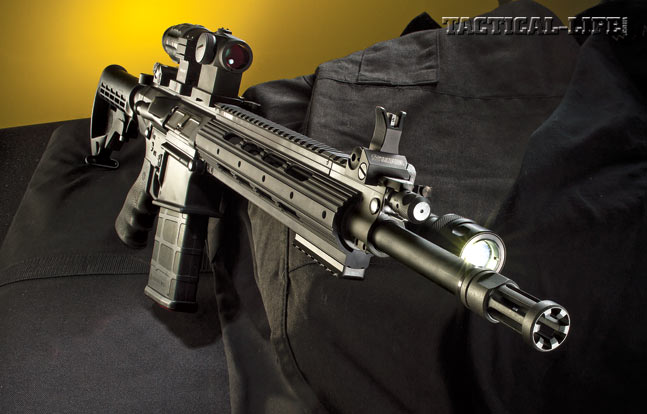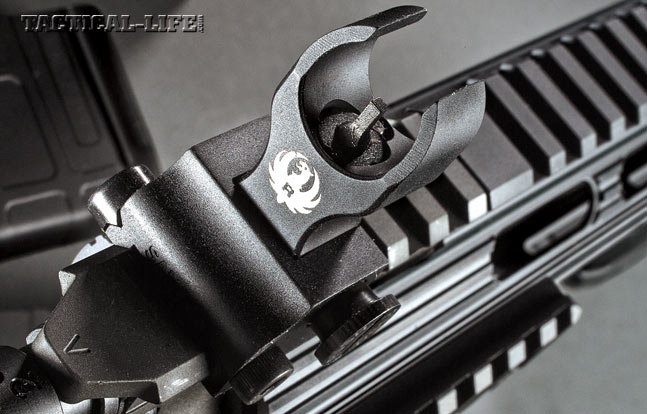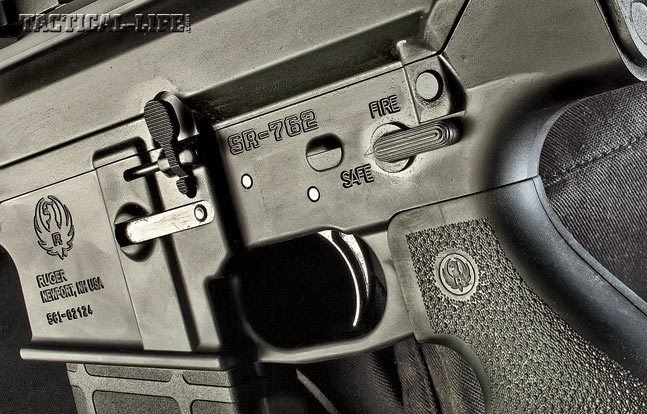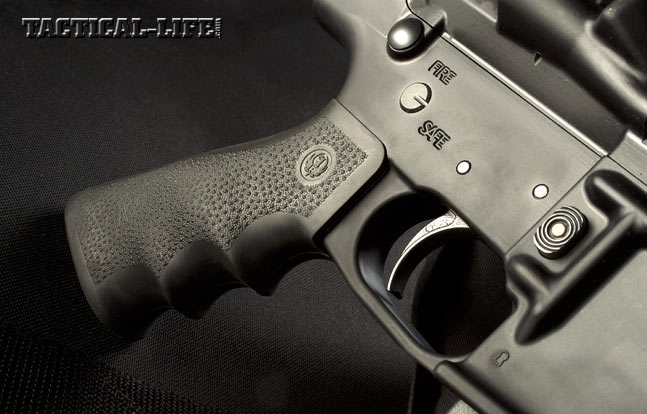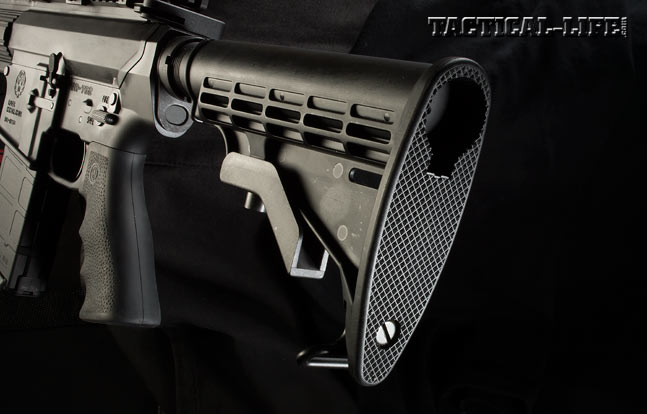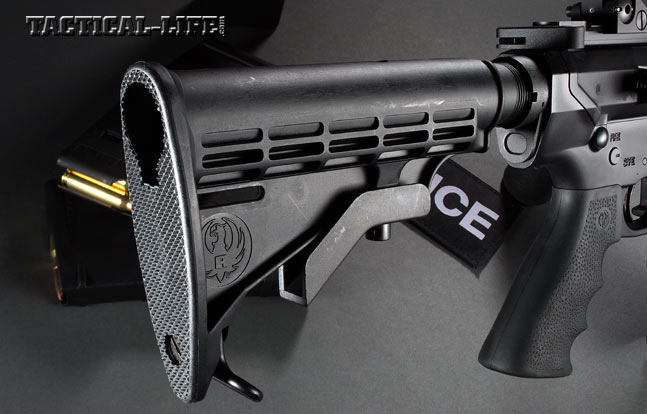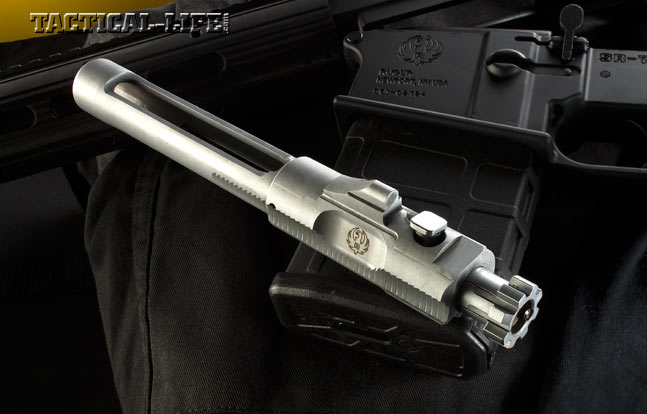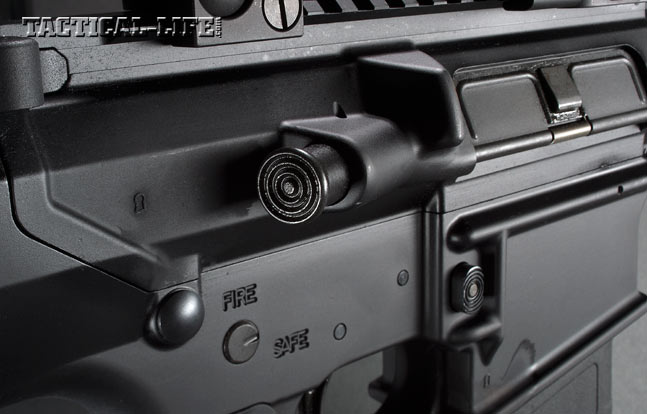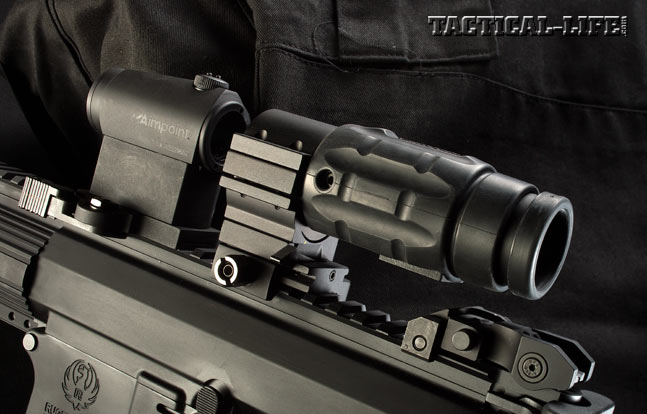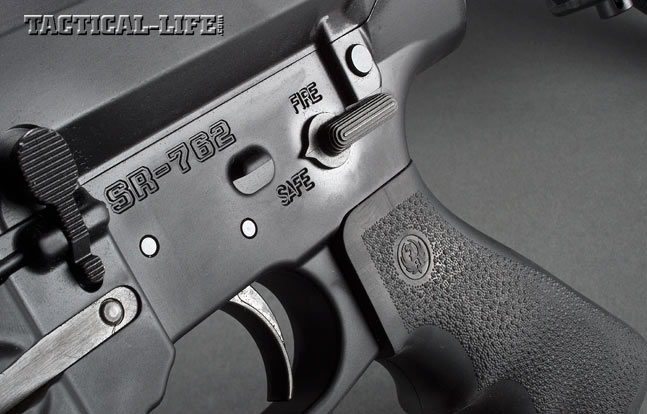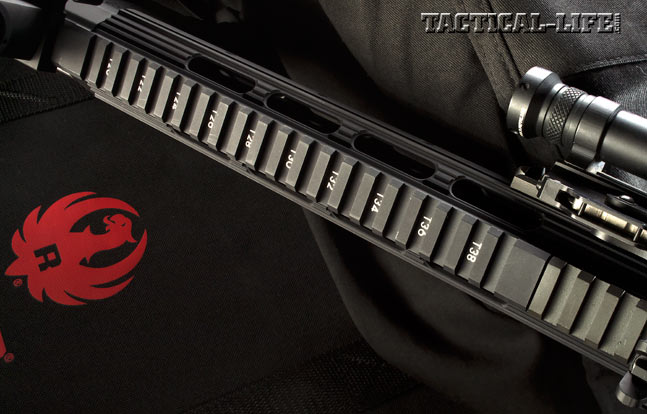Ruger’s newest rifle is the SR-762, which is essentially an AR-style rifle chambered for the 7.62mm NATO cartridge. These rifles are, for the most part, grown-up versions of the AR-15. However, Ruger’s new rifle is not just one of these—it is a piston-driven variant as well. Just like the argument between the 5.56mm and the 7.62mm, there also exists an argument about whether an AR that is piston driven is better than an AR that operates on the original direct gas impingement design. The difference between the two operating mechanisms is easier to quantify than which is the best option. The direct impingement system forces gas into the receiver, which operates the bolt carrier. With the piston system, gas is used to push a piston against the bolt carrier and the gas is vented outside the rifle.
Proponents of the piston system like to point out that piston guns run much cleaner and cooler. Those who believe in the direct gas impingement system argue that piston-driven guns are not as accurate. Across the board, the accuracy argument is hard to validate. However, it’s crystal clear that piston guns stay cleaner and cooler. From a law enforcement standpoint, I’m not sure that cleaner and cooler matter all that much, given that even prolonged engagements will likely not consume enough ammo to make the gun so dirty or so hot it will not work. But, on a battlefield, the cleaner and cooler advantage is much easier to get behind, and let’s face it, many cops don’t like to clean guns.
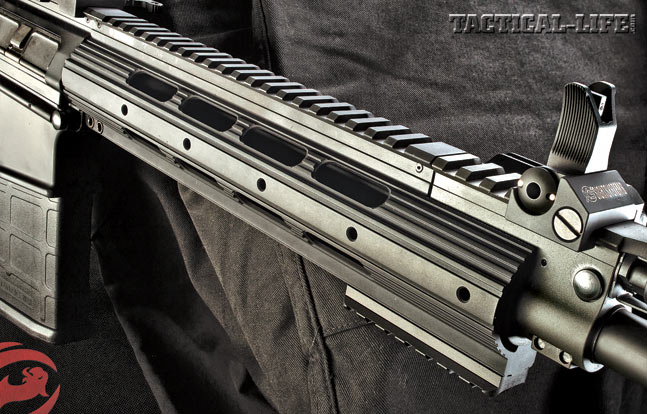
Gun Details
Advertisement — Continue Reading Below
Regardless, Ruger opted to go with the piston system on the SR-762, just as the company did with its earlier and very successful SR-556 (Click here to read a review). The piston on the Ruger SR-762 is a two-stage affair that works behind a multi-adjustable regulator that has four settings. In the “0” setting, no gas is driven into the piston and the rifle works like a single-shot, requiring the shooter to operate the action with the charging handle to extract and eject the fired case as well as to chamber a new cartridge.
“The rifle comes with two 3-inch sections of rail and three grooved, 5.75-inch covers…”
Ruger advises that the number “2” setting will most likely offer the best functioning and reliability with most factory loads. The neatness of this design is that you can tune the piston system to work perfectly with the ammo you are using. If spent cases are landing well behind you (what is called “late ejection”), move the regulator to a setting with a larger number. This increases the gas port size and forces more gas against the piston. If spent cases are landing well in front of you (“early ejection”), move the setting to a smaller number, thus decreasing the amount of gas that will pass through the port.
This piston system is concealed underneath a very comfortable to grasp aluminum handguard. This very ergonomic handguard is taller than it is wide and has multiple holes along the sides and top for the attachment of rail sections or handguard covers. The rifle comes with two 3-inch sections of rail and three grooved, 5.75-inch covers. The top, front of the rail is cut out for the large gas block with its integral regulator, and the top of the handguard has a 9-inch section of Picatinny rail. This rail mates to the 3-inch section of rail that is integral to the gas block as well as to the rail on the upper receiver.
Advertisement — Continue Reading Below
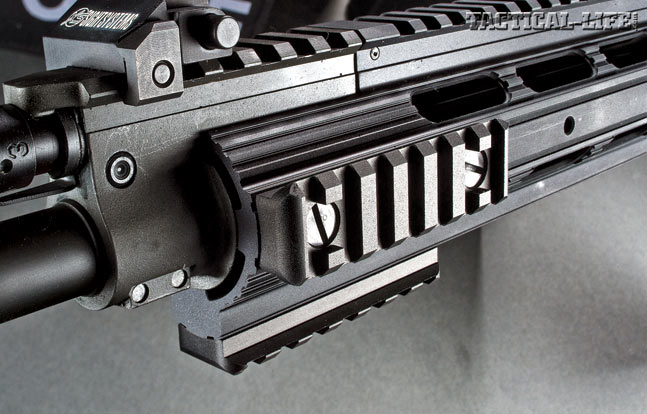
The flattop upper receiver has sort of an octagonal shape, and the rail section is 7 inches long with 14 slots. There is also the customary forward assist and dust cover found on most AR-style rifles. Out of the box, the rifle has folding rear and front sights attached to the rail of the upper receiver and the gas block, respectively. The front sight is adjustable for elevation like common A2-style sights, and the rear sight is thumb-knob adjustable for windage and has a folding aperture with small and large holes. The lower receiver is exactly what you would expect of an AR-style rifle with the possible exception of the integral triggerguard.
The muzzle of the 16.12-inch, hammer-forged barrel is threaded and comes with a flash suppressor installed. Sound suppressor installation is an option, and the adjustable/regulated gas block should allow the rifle to be tuned for suppressor use. The rear stock is the common six-position adjustable, mil-spec-style stock. The other feature of note is the chrome-plated bolt and one-piece bolt carrier, which has an oversized and radiused rear bearing surface. The plating makes both parts easier to clean, though fouling with the piston system is negligible.
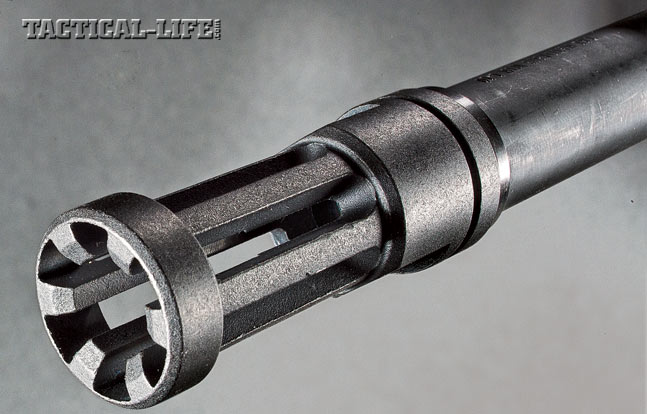
5/8-24 threading for installing a suppressor.
Range Time
Advertisement — Continue Reading Below
With a Nightforce 2.5-10x42mm NXS Compact riflescope installed, I tested the Ruger SR-762 with five loads with bullets ranging in weight from 155 to 200 grains. There were no malfunctions. Ejection was positive and maybe only a slight bit early. However, no adjustments were made to the gas regulator, which came out of the box on the number “2” setting. Accuracy was better than expected for a piston-driven AR. The best five-shot group fired at 100 yards measured just a tad under 0.75 inches, and it was achieved with the DoubleTap 200-grain load. The worst group was fired with the 155-grain Black Hills load, which this particular test rifle did not like.
Even considering the accuracy delivered by the 155-grain A-MAX load, the rifle still averaged 1.75 inches for 25 five-shot groups with five different loads. The DoubleTap load averaged 1.13 inches. It would likely have been a sub-MOA performer, but your humble correspondent messed up the first group fired, opening it up to 2.32 inches. The other four groups fired with this load all measured less than 1 inch.
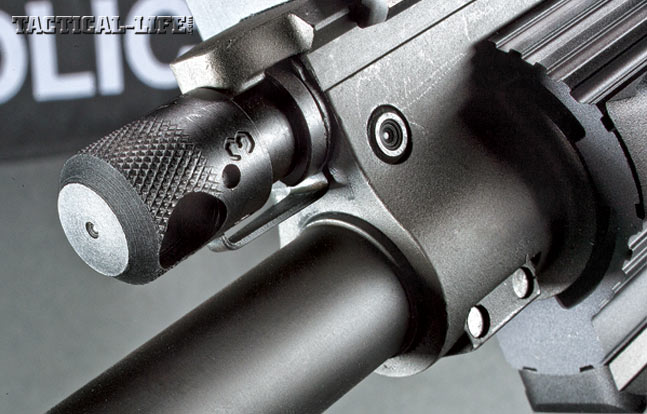
Final Thoughts
Advertisement — Continue Reading Below
When it comes to whether police should be armed with a 5.56mm or a 7.62mm NATO patrol rifle, it can be debated, and valid arguments can be presented on both sides. The 5.56mm rifle will weigh less, allow you to carry more ammo and is easier to shoot. The 7.62mm offers more power and can offer farther reach. From a law enforcement perspective, the choice should be made on potential application instead of emotional bias.
“I’d rate the Ruger SR-762 as the finest 7.62mm NATO AR I’ve handled. This is a dandy rifle that any patrol officer, designated marksman, hunter or recreational shooter should be proud to own…”
Many law enforcement officers work in rural country where they might encounter a longer shot at a bad guy and possibly a dangerous critter. You can kill any game animal in America with a 5.56mm, but the 7.62mm will deliver more damage to the critter, particularly if bad shot angles are all that is presented. And, let’s face it, sometimes cops
may be called to shoot rogue bears, cougars and even ungulates like elk and moose.
Additionally, the most common designated marksman rifle in law enforcement is chambered for the 7.62mm NATO/.308 Winchester. So, an argument can be made for a patrol rifle in the same chambering and of the same design since it will allow for ammo/magazine sharing and armorer friendliness. This is especially true if the patrol rifle is a semi-automatic rifle, allowing volume fire and precision shot placement.
Advertisement — Continue Reading Below
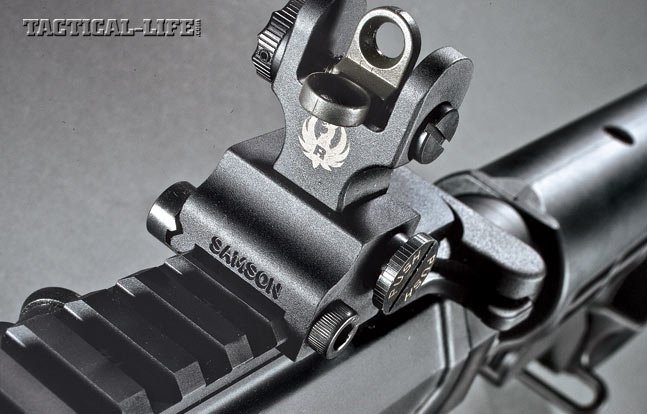
The arguments over whether the 5.56mm or the 7.62mm NATO would make the best police rifle will likely go on endlessly, as will the arguments about direct impingement versus gas piston systems. Until handling and shooting the SR-762, I was leaning toward the 5.56mm. This carbine sort of changed my mind, and in all honesty, it is the first 7.62mm AR-style rifle I have seriously considered purchasing. It is suitable for up-close dynamic work or for serious long-range employment. It was also comfortable and fast to shoot from field positions and unfailingly reliable. My badge has long since been turned in, so at least for me, the rifle’s applicability to law enforcement use is a non-issue. However, if you wanted one rifle to depend on for survival during just about any situation, you’d be hard pressed to find a better option.
I’d rate the Ruger SR-762 as the finest 7.62mm NATO AR I’ve handled. This is a dandy rifle that any patrol officer, designated marksman, hunter or recreational shooter should be proud to own. It is as accurate as any AR-style carbine I’ve fired, it runs super clean and it’s very comfortable to shoot. It’s not the least expensive 7.62mm AR you can find, but the quality is clear. Ruger punched the center ring with the SR-762.
For more information, visit ruger.com.
Advertisement — Continue Reading Below
